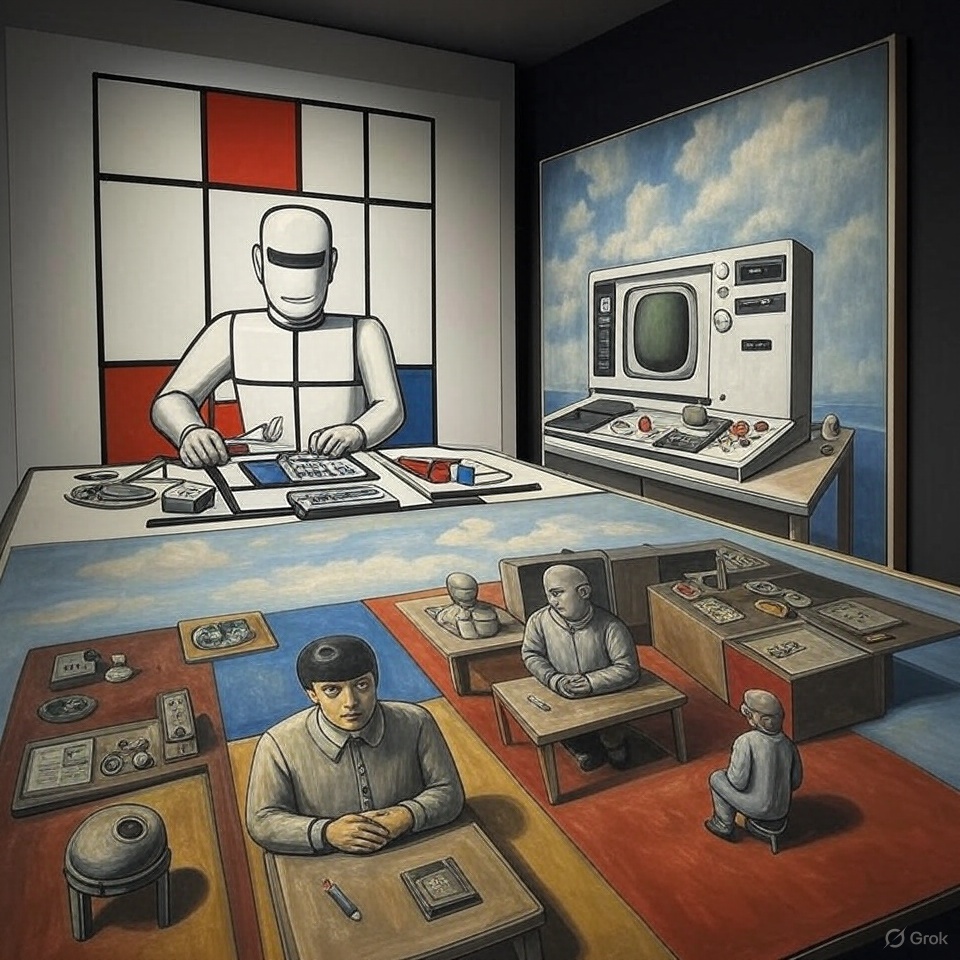This post somehow involved AI. It could have been copyediting, creating an image, or penning the whole thing in unsupervised fashion. As you know, interesting things may happen. Just like in real life. You have been warned.
The DeepMEE setup is a hardware-only ambient dub techno rig, with the Akai Professional MPC One as the primary sequencer, the Elektron Analog Rytm MkI as the drum machine, and the Solid State Logic BiG SiX as the mixer. It integrates synthesizers like the Access Virus B and Behringer DeepMind 6, alongside effects units such as the Eventide Eclipse and Line 6 M9. The MPC and Analog Rytm were chosen early on for their performance flexibility, while the BiG SiX was selected for its seamless USB integration with the MPC and iConnectivity mioXL MIDI interface. No computers or modular systems were used, prioritizing a tactile, standalone workflow.
Governing Ideas
a) Hardware for Performance Feel
Hardware was chosen for its pre-mapped controls, enabling intuitive live performance. The BiG SiX’s one-knob-per-function design exemplifies this, offering immediate mixing adjustments. This tactile approach aligned with the project’s performance-driven goals.
b) Dual Sequencer Approach
Using separate sequencers for pitched parts (MPC) and drums (Analog Rytm) allowed independent control during performances. The MPC’s powerful sequencing, USB integration, and sample playback suited ambient textures, while the Analog Rytm’s versatile drum synthesis and individual outputs were ideal for dub techno’s layered processing.
c) Dub Techno’s Independent Parts
Dub techno relies on independently processed parts for spatial depth. The dual sequencers and BiG SiX enabled separate routing and real-time manipulation, supporting the genre’s characteristic sound.
How It Worked
The setup delivered a tactile, engaging performance experience. Hands-on control across devices, from the Line 6 M9 to the DeepMind 6, was a highlight, with the M9 and DeepMind feeling more immediate than the MPC or Eclipse. The dual sequencer approach shone, with the MPC’s sequencing power and the Analog Rytm’s drum flexibility complementing each other. However, the MPC’s software limitations in track and program change handling reduced immediacy, though a planned workflow mitigated this. The BiG SiX’s limited inputs were a constraint; a Tascam Model 24 would have been preferred. Despite these, recordings aligned with influences like Yagya, Monolake, and DeepChord, achieving the desired aesthetic.

The Paralogues
Paralogue 2 established a standalone Roland MC-707 setup (“DeepMC,” 126 BPM), which was functional. Alternatives like M77 (MPC + MC-707) or 7EE (MC-707 + Analog Rytm) were viable but not pursued, as MEE met the project’s goals. Paralogue 3’s modular Eurorack setup was considered but closed as too complex. Computer-based setups were excluded to maintain the hardware-only focus.
Was MEE the Right Choice? Alternatives and Future Focus
The MEE setup was effective, delivering independent control and a tactile performance feel. The Analog Rytm’s immediate sound design and the BiG SiX’s integration were strengths, but the MPC’s track handling limitations hindered immediacy, though manageable with planning. The BiG SiX’s input constraints suggested a Tascam Model 24 would have been ideal if available. Alternatives like M77 (MPC + MC-707) or 7EE (MC-707 + Analog Rytm) were feasible, with a TR-8S potentially enhancing drum synthesis (M88). Portability was not prioritized, but a future gig setup could involve prerecorded MPC tracks remixed live with the Eclipse, M9, and BiG SiX. An MC-707 with an SP-404.2 sampler could replace the MPC for simplicity. Further reuse discussions are planned for later.
Annex
Bill of Materials (BOM):
- Akai Professional MPC One
- Elektron Analog Rytm MkI
- Synthesizers: Behringer DeepMind 6, Access Virus B
- Effects: Eventide Eclipse, Line 6 M9, Behringer VD400, TC Electronic Blood Moon Phaser, Electro-Harmonix Stereo Memory Man with Hazarai, Tech 21 SansAmp
- Compressors: Fredenstein FET, Alesis 3630, Alesis NanoCompressor
- Processors: Elysia xfilter, SPL Vitalizer Mk.2, Aphex Dominator II
- Solid State Logic BiG SiX
- iConnectivity mioXL
- Zoom H8
Audio Routing:
- Inputs:
- Ch1: Virus B (bass, part 3, MIDI Ch3, Out2 L) -> SansAmp (EQ, drive) -> Alesis 3630 Ch2 (insert, sidechain triggered by Rytm BD)
- Ch2: EAR Bass Drum -> Fredenstein FET (insert)
- Ch3: EAR Snare -> VD400 -> Alesis 3630 (insert)
- Ch4: EAR Hi-Hat -> TC Electronic Blood Moon Phaser -> Fredenstein FET (insert)
- Ch5/6: EAR stereo output or MPC Mellotron (USB, 2: Mellotron, switchable via BiG SiX)
- Ch7/8: Virus B (stabs) -> Stereo Memory Man with Hazarai
- Ch9/10: DeepMind 6 (pads)
- Ch11/12: MPC One (Ambient, 1: Ambient) via USB
- Ext1: Eclipse (SC2 return)
- Ext2: M9 (SC1 return)
- Send/Return: SC1 -> M9 (Ch4, Ch9/10 typically), SC2 -> Eclipse (Ch9/10 typically, Ch3/4/5/6/7/8/11/12 possible), no SC for Ch1/2
- Output: Main inserts: xfilter -> Vitalizer Mk.2 -> SSL bus compressor; Main out: Dominator II -> Zoom H8
